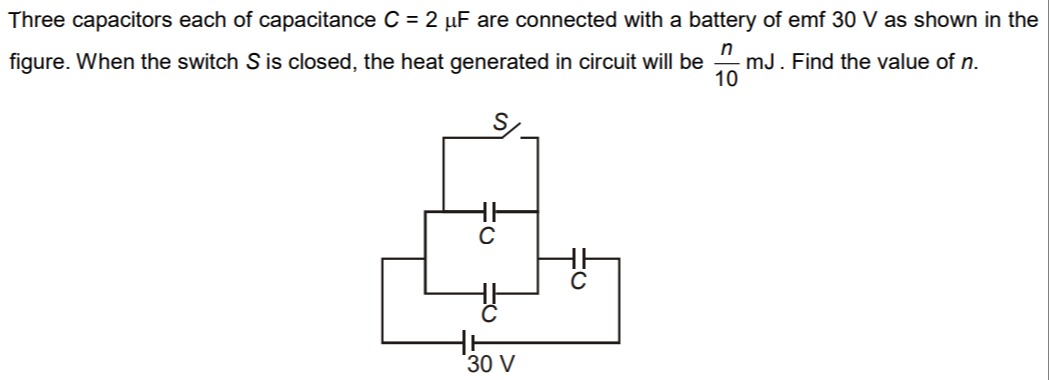Question
Question: Three capacitors each of capacitance $C = 2 \mu F$ are connected with a battery of emf 30 V as shown...
Three capacitors each of capacitance C=2μF are connected with a battery of emf 30 V as shown in the figure. When the switch S is closed, the heat generated in circuit will be 10nmJ. Find the value of n.

19.5
Solution
The heat generated in the circuit when the switch is closed is given by H=Wbattery−ΔU, where Wbattery is the work done by the battery and ΔU is the change in the total potential energy stored in the capacitors. The work done by the battery is Wbattery=VΔQ, where V is the battery voltage and ΔQ is the total charge supplied by the battery.
Initial state (switch open):
Let the potential of the bottom wire connected to the positive terminal of the battery be V+=30V and the potential of the point connected to the negative terminal be V−=0V. Let the potential of the middle wire be Vm and the potential of the top wire be Vt. The bottom capacitor C1 is connected between V+ and Vm. The middle capacitor C2 is connected between Vm and Vt. The right capacitor C3 is connected between Vm and V−. With the switch open, the top wire is isolated. Assuming the capacitors were initially uncharged before connecting the battery, and then the battery was connected with the switch open, the net charge on the isolated plates (top plate of C2) remains zero. However, if the circuit has been in this configuration for a long time, the potentials will be determined by the connections.
Let's assume the interpretation of the diagram where the bottom wire is at 30V, the right point is at 0V.
Initial state (switch open): Capacitor C1 is between 30V and Vm. Capacitor C2 is between Vm and Vt. Capacitor C3 is between Vm and 0V. Since the top wire is isolated, no charge flows to it. If the capacitors were initially uncharged, then the charge on the top plate of C2 is q2,top=C(Vt−Vm). Since the wire is isolated, q2,top should be zero. This implies Vt=Vm. If Vt=Vm, then the potential difference across C2 is zero, so its initial charge and energy are zero. Then C1 is between 30V and Vm, and C3 is between Vm and 0V. These two capacitors are in series connected between 30V and 0V. Equivalent capacitance of C1 and C3 in series is C13=C+CC×C=2C. The potential difference across the series combination is 30V. The charge on each capacitor is Qinitial=C13×30=2C×30=15C. Vm is the potential between C1 and C3. Potential difference across C3 is Vm−0=Vm. Charge on C3 is CVm=15C. So Vm=15V. Potential difference across C1 is 30−Vm=30−15=15V. Charge on C1 is C(30−Vm)=C(15)=15C. This is consistent. So, in the initial state (switch open), Vm=15V and Vt=15V. Initial potential energy stored in the capacitors: Uinitial=21C1(30−Vm)2+21C2(Vt−Vm)2+21C3(Vm−0)2 Uinitial=21C(30−15)2+21C(15−15)2+21C(15−0)2 Uinitial=21C(15)2+0+21C(15)2=2×21C(225)=225C.
Final state (switch closed): The switch connects the top wire to the 0V terminal. So Vt=0V. Capacitor C1 is between 30V and Vm. Capacitor C2 is between Vm and Vt=0V. Capacitor C3 is between Vm and 0V.
Let's use nodal analysis in the final state. Let Vm be the potential of the middle wire. The bottom wire is at 30V, and the top wire and the right point are at 0V. Charge conservation at node Vm: The sum of charges on the plates connected to Vm is zero. The top plate of C1 is at Vm, bottom plate at 30V. Charge on top plate is Q1,top=C(Vm−30). The bottom plate of C2 is at Vm, top plate at 0V. Charge on bottom plate is Q2,bottom=C(Vm−0)=CVm. The top plate of C3 is at Vm, bottom plate at 0V. Charge on top plate is Q3,top=C(Vm−0)=CVm. Sum of charges on the plates connected to Vm: Q1,top+Q2,bottom+Q3,top=0. C(Vm−30)+CVm+CVm=0 Vm−30+Vm+Vm=0 3Vm=30 Vm=10V.
Final potential energy stored in the capacitors: Ufinal=21C1(30−Vm)2+21C2(Vm−Vt)2+21C3(Vm−0)2 Ufinal=21C(30−10)2+21C(10−0)2+21C(10−0)2 Ufinal=21C(20)2+21C(10)2+21C(10)2=21C(400)+21C(100)+21C(100) Ufinal=200C+50C+50C=300C.
Change in potential energy: ΔU=Ufinal−Uinitial=300C−225C=75C.
Work done by the battery: Wbattery=VΔQ, where ΔQ is the total charge supplied by the battery from the positive terminal. The positive terminal is connected to the bottom wire.
The change in charge on the bottom plate of C1 is 20C−(−15C)=35C. This is the charge that flowed from the battery. So, ΔQ=35C. Work done by the battery: Wbattery=30V×35C=1050C.
Heat generated: H=Wbattery−ΔU=1050C−75C=975C. Given C=2μF=2×10−6F. H=975×2×10−6J=1950×10−6J=1.95×10−3J=1.95mJ.
The heat generated is given as 10nmJ. So, 1.95mJ=10nmJ. 1.95=10n n=1.95×10=19.5.
